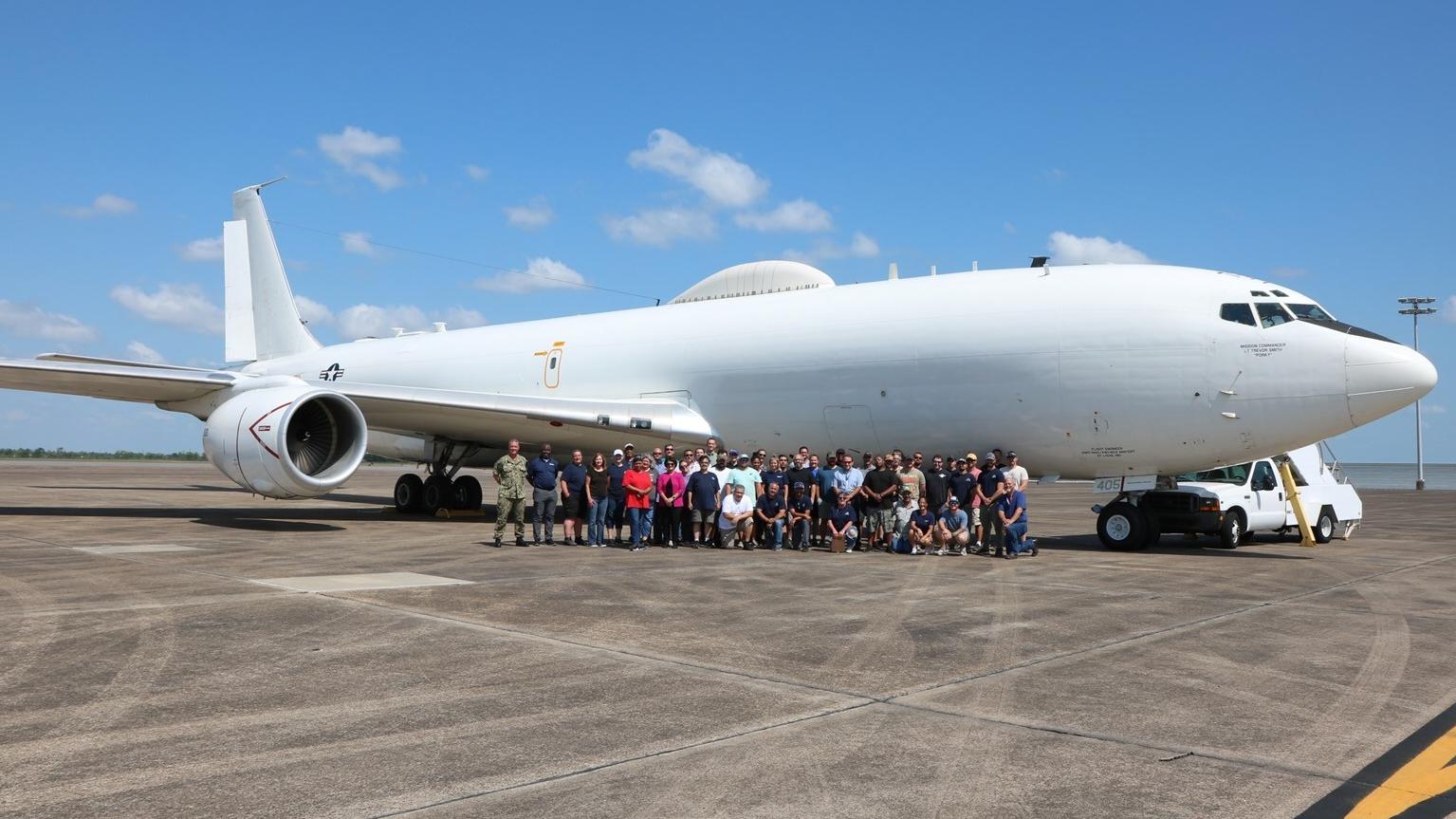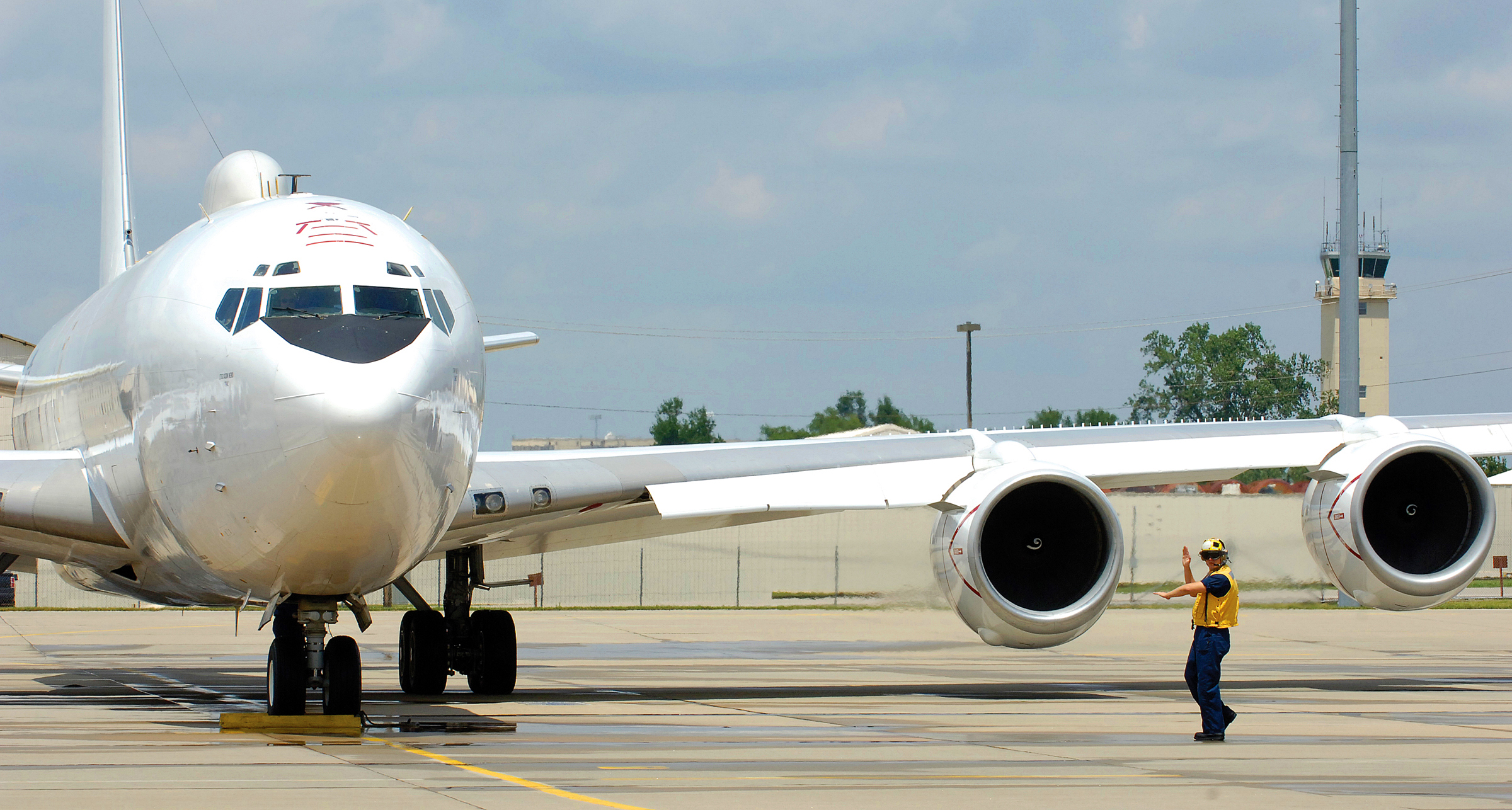Navy E 6b - The primary mission of the E-6 Mercury is to link the national command authority of the US Navy's nuclear missile force, which is carried aboard ballistic missile submarines at sea. The E-6 is a militarized version of the 707 commercial airliner and carries a very low frequency communications system with twin wire antennas.
The E-6B was designed as a replacement for the Air Force Air Command post due to the aging of the EC-135 fleet. The E-6B modified an E-6A by adding combat personnel positions and other special equipment.
Navy E 6b

The E-6B is a dual-mission aircraft capable of either the E-6A mission or the Air Strategic Command Post mission and is equipped with an Airborne Launch Control System (ALCS). The ALCS is capable of launching US land-based intercontinental ballistic missiles. The first E-6B aircraft were received in December 1997, and the E-6B assumed dual operational duty in October 1998. The E-6 fleet was fully converted to the E-6B configuration in 2003.
United States Navy Boeing E 6b Mercury Photo By Stephen J Stein
Boeing is retiring the E-6A from the commercial 707 to replace the aging EC-130Q in the Navy's TACAMO ("Take Charge and Move Out") mission. TACAMO links NCA with naval ballistic missile forces in times of crisis.
Ukrainian forces have used self-propelled artillery in an effort to push Russian forces away from the country's second largest…
Real-life Top Gun pilots take to the skies in F-35 fighter jets. It is billed as the most…
The Ukrainian military is using US M777 howitzers on the battlefield as they try to push Russian forces into…
Pma 271 Works Quickly To Purchase E 6b Trainer Aircraft
A Navy plane crashed in the Southern California desert on Wednesday, and civilians and emergency crews responded…
Satellite images of Ukraine's Snake Island released Friday show a group of sunken Russian ships...
Future Destroyer Will Honor Vietnam War Hero Navy Secretary Carlos Del Toro announced that one of the service's new, yet-to-be-built destroyers will be named for the…

The Navy may have to choose between arming the service and supporting Ukraine because of munitions delays, with officials saying delays in munitions production are jeopardizing U.S. aid to Ukraine.
Boeing E 6b Hi Res Stock Photography And Images
Ukrainian troops train on Patriot system in Oklahoma Kiev's decision to take troops off the battlefield to train across the Atlantic in the US is unusual.
Marines say new uniform orders on the way amid shortage The Marine Corps continues to face shortages of uniforms, including the commonly used combat jacket, but ...
Canada has finalized a deal to buy 88 US F-35 fighter jets. The first four aircraft are expected to be delivered in 2026, with full operational capability for the fleet estimated between ... WASHINGTON — The head of the US Strategic Command asked the Navy to lay the foundation for the future command and control aircraft, one that may include a joint development of the Air Force.
Gen. John Hyten, who took over at STRATCOM in November, told members of Congress on Wednesday that the Navy has begun planning for the eventual replacement of the E-6B fleet, which provides airborne command, control and communications between the National Command Authority and US strategic authorities. and non-strategic forces, although those planes are not expected to fly until 2038.
Boeing E 6 Mercury
Although Hyten said the plan is still in the early stages of analysis, he told reporters after his hearing that the reality of defense procurement means the work must begin now.
"We're only 20 years away from 2038, so if you're going to build a big plane with a lot of command and control [requirements], you have to start thinking about things now," Hyten said. "That's what the Navy is starting to do, I'm asking them to start looking at determining what's next."
Hyten and Adm. Bill Moran, deputy chief of naval operations, said there is benefit to working with the Air Force and developing a platform to manage various command and control missions, with Moran telling Congress, "We are looking for a way to come to a common program, or at least a common structure, to fulfill both missions."
The Navy's fleet of 16 E-6B aircraft is based on a commercial Boeing 707 airframe, the same airframe the Air Force uses for most of its command and control assets, including the E8-C Joint Surveillance Targeting Attack. Radar System, the E-3 Sentry airborne warning and control aircraft, the RC-135V/W Rivet Joint reconnaissance aircraft and the OC-135B Open Skies aircraft.
United States Navy Boeing E 6b Mercury Airborne Command Aircraft Arrival And Landing For Riat Royal International Air Tattoo 2018 Editorial Stock Photo
The Air Force has warned that those platforms have excessive airframe wear and tear and maintenance is becoming too expensive because of parts that are no longer manufactured for the 707. According to a 2015 report by the Congressional Research Service, the E- 6B aircraft have an average age of 21 years.
Moran told Congress that while the Navy could phase out the E-6B fleet by 2038, that would be beyond the limits of the airframes.
"The 707s are very old airplanes, and they will be very old when we get to the end of life, based on the life extension that we're looking at," he told reporters, before adding that it It only makes sense that we see if the Navy and Air Force can come together to do something to reduce costs.
However, this does not mean that there is one platform for all surveillance missions. As Moran pointed out, the plane itself is just a "truck" that carries the important equipment inside. At the same time, Moran acknowledged that there may be benefits to be shared from the ongoing recapitalization efforts for JSTARS.
E 6b Mercury: More Than The Doomsday Plane
"We're always looking for areas that we can't duplicate ... [that] allow us to do it at the lowest possible cost because they've already been developed, or we've been developed," he said. "Part of that is our responsibility to make sure we do it at the best cost to the American taxpayer, and part of that involves sharing technology and ideas."
The aging E-6B fleet is just one part of an aging nuclear command and control infrastructure that Gen. Paul Selva, the vice chairman of the Joint Chiefs of Staff, which is "strong, strong - and old."
Selva later said that while the command and control structure is working now, he is concerned 10 years from now and called it "my No. 1 priority. 1" among the overall nuclear modernization efforts currently underway. at the Pentagon.

A recent report by the Congressional Budget Office put the cost of repairing the nuclear command and control infrastructure at $58 billion over the next decade.
The Boeing E6 Mercury
Aaron Mehta is deputy editor and senior Pentagon correspondent for Defense News, covering policy, strategy and acquisitions at the highest levels of the Defense Department and its international partners.
Will Ukraine War Slow Russia's Arctic Push? Drones could give the West an opening to catch up with Russia, which is stuck in Ukraine, by establishing a foothold in the warming Arctic.
The US Army has rolled out the Google collaboration suite to more than 180,000 employees. Absolutely not".
Lawmakers chart 'middle course' on space-based missile warning funding. Does this mean MPs support his strategy?
A Us Navy E 6b Mercury Climbing Out Of Raf Mildenhall. These Aircraft Are Used To Communicate With Submerged Missile Submarines Stock Photo
The Air Force and Space Force are targeting AI readiness by 2025. To achieve AI readiness, the Department of the Air Force must continue to invest in training and infrastructure, the AI and data chief said.
The US Air Force wants input from industry on "breakthrough" ABMS technologies. The Air Force is particularly interested in commercial equipment that can withstand jamming and increase data transfer rates and reduce latency. "E-6B" redirects here. For an analog flight computer, see E6B. For the road in Pakistan, see Highway E6B (Pakistan)
The Boeing E-6 Mercury (formerly Hermes) is an airborne command post and communications relay based on the Boeing 707. The original E-6A manufactured by Boeing's defense division entered service with the United States Navy in July 1989, replacing the EC - 130Q. . This platform, now modified to the E-6B standard, sends instructions from the National Command Authority to launch ballistic missile submarines (see submarine communication), a mission known as TACAMO ("Take Charge And Move Out"). The E-6B deployed in October 1998 also has the capability to remotely control Minuteman ICBMs using the Airborne Launch Control System. The E-6B replaces the Air Force EC-135C in the Looking Glass role, providing command and control of US nuclear forces when ground control becomes unavailable. With production lasting until 1991, the E-6 was the last new Boeing 707 derivative to be built.

Like the E-3 Stry Airborne Warning and Control System (AWACS) aircraft, the E-6 is adapted from the Boeing 707-320 airliner. Launched at the Boeing Rton factory on December 18, 1986,
United States Navy
The first E-6 made its service flight on 19 February 1987, when it was flown to nearby Boeing Field in South Seattle for installation of mission avionics; sent to Navy for trial on 22 July 1988 (34 years ago) (1988-07-22).
The E-6A, originally designated Hermes, ceased service with the VQ-3 squadron on 3 August 1989. The second squadron, VQ-4, received its first E-6A in January 1991, allowing the phase out in EC-130Q.
Sig p365 tulster holster, sig p365 iwb holster, sig holsters p365, sig p365 sas holster, sig p365 xl holster, sig p365 hybrid holster, appendix holster sig p365, safariland holster sig p365, sig p365 belt holster, sig p365 holster, sig p365 purse holster, sig sauer p365 holster

0 Comments